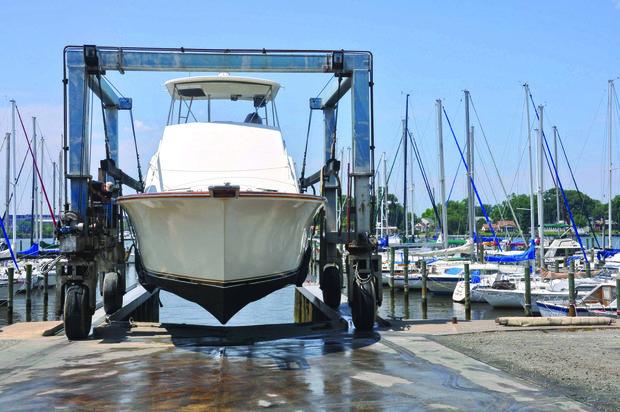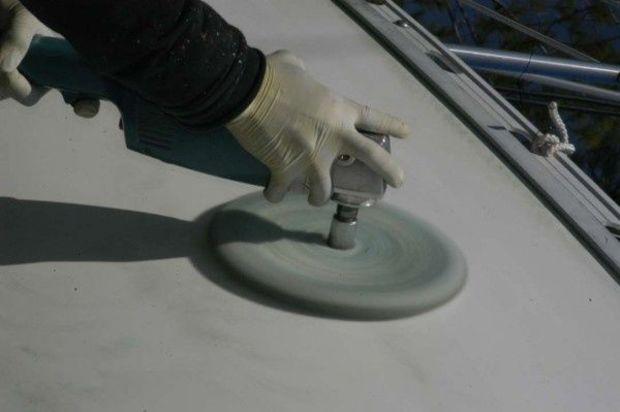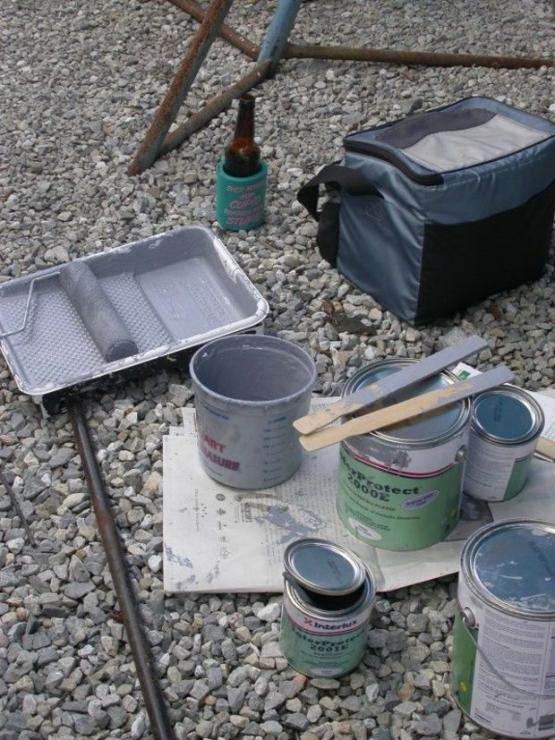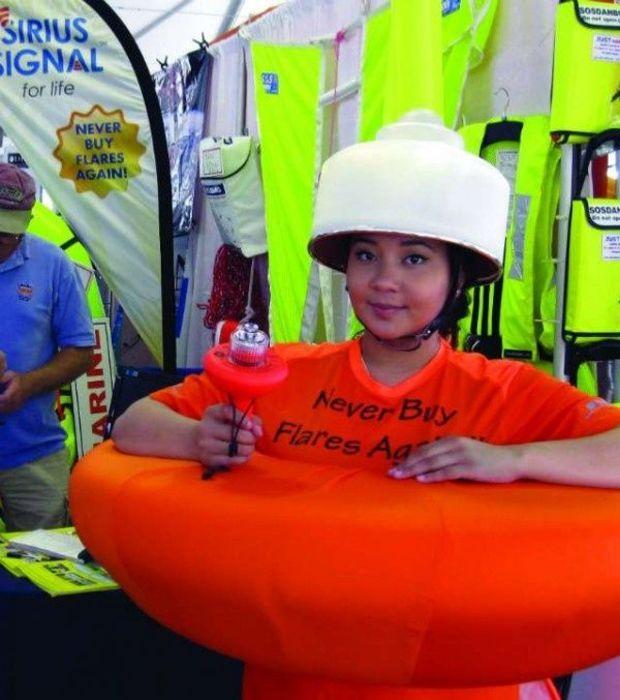For some it’s the smell of the daffodils. For others it’s the smell of bottom paint… or fish! Boaters can smell it coming… Spring is about to blossom along the Chesapeake! Some boaters are busily preparing their boats; others are just thinking about it. One word of advice: don’t put it off too long. You don’t want to be the one waiting on shore when your dockmates head out to savor that first perfect spring day. In this special section, we’ve gathered some words of wisdom and resources to guide you as you ready your boat and crew for launch day.
 Tips from a Pro
Don’t expect to do a two-week cruise the day the boat is commissioned…
Tips from a Pro
Don’t expect to do a two-week cruise the day the boat is commissioned…
What do boaters tend to forget when commissioning their boats? We got some solid advice about getting boats ready for spring from Mike Bonicker, production manager at Tidewater Yacht Service in Baltimore.
“Some people forget their registration expires,” he said. “They forget to put the new sticker on.” (Sound familiar?)
He also recommended checking your flares to make sure they have not expired and making sure your lifejackets are in decent condition.
This one’s really important if you’d prefer your boat not sink first thing this spring: “Whether you do the work yourself or not, all hoses must be reconnected to thru hulls,” says Bonicker. “Check water level in batteries if you have wet cell batteries.”
As most of his customers have his crew do the work, he admits that he’s not sure what other advice to give to do-it-yourselfers. The advantage of the work he and his team do is that they’ve winterized these boats and then will commission them. They keep good records. “We have a handle on it,” he says.
“If you’re not going to be there to launch your boat, make sure the guys at the boatyard have your keys so they can make sure there are no leaks,” he adds.
If you do have someone else do the work, Bonicker says, “Make sure you schedule early to get your boat in the water when you’re hoping to. There are only so many boats that can be launched in a week, so we try our best—you’ll want to get in early.”
We asked the Baltimore-based manager what he likes best about the spring season at Tidewater. He says, “It’s never a bad thing to be busy. Life becomes much more hectic, but you do what you have to do. Because it’s spring, which you want anyway, the extra business and organization are easier to take.”
What can be challenging? “The biggest issues we run into are people who have winterized and not done so correctly, and there’s damage… Don’t expect to do a two-week cruise the day the boat is commissioned. Take a few days to make sure all is well. There is still a chance there’s something that needs service or attention before you go traveling far and wide. Take a day trip. Spend a day going over stuff.”
For Bonicker and other Chesapeake boatyard managers, peak season runs from mid-April through June; if it’s warmer earlier, the season starts sooner. The busiest month tends to be May and right before Memorial Day, especially for smaller boats, so keep that in mind as you plan.
 Spring Commissioning Resources
Spring Commissioning Resources
Whether you’re a do-it-yourselfer, someone who hires marine professionals to work on their boats, or a little of both, here are some tried and true resources to make sure your spring commissioning goes smoothly.
Where do I find a thorough checklist?
BoatU.S.—
boatus.com/seaworthy/spring_checklist.asp
Discover Boating—
discoverboating.com/owning/maintenance/startup.aspx
American Boating Association—
americanboating.org/springcommissioning.asp
Your marina—if you have a full-service marina, it may post a thorough spring commissioning checklist online.
 How do I paint like a pro?
How do I paint like a pro?
Interlux offers free expert advice online through its “ask the expert” feature as well as featuring an extensive online video library
yachtpaint.com/usa/diy
Among the top five most common questions are: How do I paint my topsides? Which varnish should I choose? Which antifouling improves fuel efficiency? The Interlux website also gives detailed equipment needs for DIYers (there’s advice for professionals, too).
Can I find an expert to inspect my boat?
U.S. Sail and Power Squadrons—Locate your local squadron. Many have checklists, advice, and someone who will do a safety vessel check for you.
usps.org
U.S. Coast Guard Auxiliary—Once the boat is commissioned and in the water, a volunteer can do a vessel safety check.
cgaux.org
What Safety Equipment Should I check?
- Check your sound signaling device
- Check distress signals and expiration dates
- Check lifejackets
- Inspect life rings and cushions
- Check fire extinguishers and recharge if necessary
- Check and adjust compass
- Check navigation lights
- Check charts and replace as necessary
- Check radar reflector
- Check and replace first aid supplies
- Check bailer and hand pump
Top Five Reasons why Boats Sink in Spring
Courtesy of BoatU.S.
- Missing or damaged hose clamps. These clamps are often removed in the fall to winterize the engine and then forgotten about in the spring when the boat is launched. Tight spaces in engine compartments make it difficult to see some unsecured or deteriorated clamps.
- Spring rains. Combine heavy rains with leaking ports, deck hatches, cracked or improperly caulked fittings, chain plates, and scuppers clogged by leaves, and your boat could be on the bottom soon.
- Broken sea strainer. Glass, plastic, and bronze strainer bowls can be cracked or bent over in the winter if not properly winterized, allowing the water to trickle in when the seawater intake seacock is in the open position.
- Leaking stuffing box. If equipped, a steady drip from an improperly adjusted stuffing box (the “packing” around the prop shaft) has been known to swamp a boat.
- Unsecured engine hoses.
- Over the winter, freezing water can lift hoses off seacocks (valves).
Visit boatus.com to learn more.
 New Distress Light a Game Changer
New Distress Light a Game Changer
Anyone who attended the 2015 Annapolis Sailboat Show may have seen the woman dressed as a distress signal… The Annapolis-based company Weems & Plath recently announced its partnership with Sirius Signal to manufacture and market a new revolutionary electronic flare. Designed and patented by Sirius Signal, the
SOS Distress Light is made in the United States and is the
only alternative to traditional pyrotechnic flares that meets U.S. Coast Guard requirements. Unlike traditional flares, the light never expires which solves the challenge of flare disposal. $99.95. To learn more, visit
weems-plath.com or call (800) 638-0428.
 Tips from a Pro
Don’t expect to do a two-week cruise the day the boat is commissioned…
What do boaters tend to forget when commissioning their boats? We got some solid advice about getting boats ready for spring from Mike Bonicker, production manager at Tidewater Yacht Service in Baltimore.
“Some people forget their registration expires,” he said. “They forget to put the new sticker on.” (Sound familiar?)
He also recommended checking your flares to make sure they have not expired and making sure your lifejackets are in decent condition.
This one’s really important if you’d prefer your boat not sink first thing this spring: “Whether you do the work yourself or not, all hoses must be reconnected to thru hulls,” says Bonicker. “Check water level in batteries if you have wet cell batteries.”
As most of his customers have his crew do the work, he admits that he’s not sure what other advice to give to do-it-yourselfers. The advantage of the work he and his team do is that they’ve winterized these boats and then will commission them. They keep good records. “We have a handle on it,” he says.
“If you’re not going to be there to launch your boat, make sure the guys at the boatyard have your keys so they can make sure there are no leaks,” he adds.
If you do have someone else do the work, Bonicker says, “Make sure you schedule early to get your boat in the water when you’re hoping to. There are only so many boats that can be launched in a week, so we try our best—you’ll want to get in early.”
We asked the Baltimore-based manager what he likes best about the spring season at Tidewater. He says, “It’s never a bad thing to be busy. Life becomes much more hectic, but you do what you have to do. Because it’s spring, which you want anyway, the extra business and organization are easier to take.”
What can be challenging? “The biggest issues we run into are people who have winterized and not done so correctly, and there’s damage… Don’t expect to do a two-week cruise the day the boat is commissioned. Take a few days to make sure all is well. There is still a chance there’s something that needs service or attention before you go traveling far and wide. Take a day trip. Spend a day going over stuff.”
For Bonicker and other Chesapeake boatyard managers, peak season runs from mid-April through June; if it’s warmer earlier, the season starts sooner. The busiest month tends to be May and right before Memorial Day, especially for smaller boats, so keep that in mind as you plan.
Tips from a Pro
Don’t expect to do a two-week cruise the day the boat is commissioned…
What do boaters tend to forget when commissioning their boats? We got some solid advice about getting boats ready for spring from Mike Bonicker, production manager at Tidewater Yacht Service in Baltimore.
“Some people forget their registration expires,” he said. “They forget to put the new sticker on.” (Sound familiar?)
He also recommended checking your flares to make sure they have not expired and making sure your lifejackets are in decent condition.
This one’s really important if you’d prefer your boat not sink first thing this spring: “Whether you do the work yourself or not, all hoses must be reconnected to thru hulls,” says Bonicker. “Check water level in batteries if you have wet cell batteries.”
As most of his customers have his crew do the work, he admits that he’s not sure what other advice to give to do-it-yourselfers. The advantage of the work he and his team do is that they’ve winterized these boats and then will commission them. They keep good records. “We have a handle on it,” he says.
“If you’re not going to be there to launch your boat, make sure the guys at the boatyard have your keys so they can make sure there are no leaks,” he adds.
If you do have someone else do the work, Bonicker says, “Make sure you schedule early to get your boat in the water when you’re hoping to. There are only so many boats that can be launched in a week, so we try our best—you’ll want to get in early.”
We asked the Baltimore-based manager what he likes best about the spring season at Tidewater. He says, “It’s never a bad thing to be busy. Life becomes much more hectic, but you do what you have to do. Because it’s spring, which you want anyway, the extra business and organization are easier to take.”
What can be challenging? “The biggest issues we run into are people who have winterized and not done so correctly, and there’s damage… Don’t expect to do a two-week cruise the day the boat is commissioned. Take a few days to make sure all is well. There is still a chance there’s something that needs service or attention before you go traveling far and wide. Take a day trip. Spend a day going over stuff.”
For Bonicker and other Chesapeake boatyard managers, peak season runs from mid-April through June; if it’s warmer earlier, the season starts sooner. The busiest month tends to be May and right before Memorial Day, especially for smaller boats, so keep that in mind as you plan.
 Spring Commissioning Resources
Whether you’re a do-it-yourselfer, someone who hires marine professionals to work on their boats, or a little of both, here are some tried and true resources to make sure your spring commissioning goes smoothly.
Where do I find a thorough checklist?
BoatU.S.—boatus.com/seaworthy/spring_checklist.asp
Discover Boating—discoverboating.com/owning/maintenance/startup.aspx
American Boating Association—americanboating.org/springcommissioning.asp
Your marina—if you have a full-service marina, it may post a thorough spring commissioning checklist online.
Spring Commissioning Resources
Whether you’re a do-it-yourselfer, someone who hires marine professionals to work on their boats, or a little of both, here are some tried and true resources to make sure your spring commissioning goes smoothly.
Where do I find a thorough checklist?
BoatU.S.—boatus.com/seaworthy/spring_checklist.asp
Discover Boating—discoverboating.com/owning/maintenance/startup.aspx
American Boating Association—americanboating.org/springcommissioning.asp
Your marina—if you have a full-service marina, it may post a thorough spring commissioning checklist online.
 How do I paint like a pro?
Interlux offers free expert advice online through its “ask the expert” feature as well as featuring an extensive online video library yachtpaint.com/usa/diy
Among the top five most common questions are: How do I paint my topsides? Which varnish should I choose? Which antifouling improves fuel efficiency? The Interlux website also gives detailed equipment needs for DIYers (there’s advice for professionals, too).
Can I find an expert to inspect my boat?
U.S. Sail and Power Squadrons—Locate your local squadron. Many have checklists, advice, and someone who will do a safety vessel check for you. usps.org
U.S. Coast Guard Auxiliary—Once the boat is commissioned and in the water, a volunteer can do a vessel safety check. cgaux.org
What Safety Equipment Should I check?
How do I paint like a pro?
Interlux offers free expert advice online through its “ask the expert” feature as well as featuring an extensive online video library yachtpaint.com/usa/diy
Among the top five most common questions are: How do I paint my topsides? Which varnish should I choose? Which antifouling improves fuel efficiency? The Interlux website also gives detailed equipment needs for DIYers (there’s advice for professionals, too).
Can I find an expert to inspect my boat?
U.S. Sail and Power Squadrons—Locate your local squadron. Many have checklists, advice, and someone who will do a safety vessel check for you. usps.org
U.S. Coast Guard Auxiliary—Once the boat is commissioned and in the water, a volunteer can do a vessel safety check. cgaux.org
What Safety Equipment Should I check?
 New Distress Light a Game Changer
Anyone who attended the 2015 Annapolis Sailboat Show may have seen the woman dressed as a distress signal… The Annapolis-based company Weems & Plath recently announced its partnership with Sirius Signal to manufacture and market a new revolutionary electronic flare. Designed and patented by Sirius Signal, the SOS Distress Light is made in the United States and is the only alternative to traditional pyrotechnic flares that meets U.S. Coast Guard requirements. Unlike traditional flares, the light never expires which solves the challenge of flare disposal. $99.95. To learn more, visit weems-plath.com or call (800) 638-0428.
New Distress Light a Game Changer
Anyone who attended the 2015 Annapolis Sailboat Show may have seen the woman dressed as a distress signal… The Annapolis-based company Weems & Plath recently announced its partnership with Sirius Signal to manufacture and market a new revolutionary electronic flare. Designed and patented by Sirius Signal, the SOS Distress Light is made in the United States and is the only alternative to traditional pyrotechnic flares that meets U.S. Coast Guard requirements. Unlike traditional flares, the light never expires which solves the challenge of flare disposal. $99.95. To learn more, visit weems-plath.com or call (800) 638-0428.